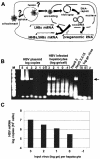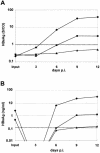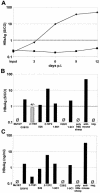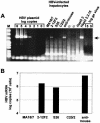Pre-s1 antigen-dependent infection of Tupaia hepatocyte cultures with human hepatitis B virus
- PMID: 12915565
- PMCID: PMC187384
- DOI: 10.1128/jvi.77.17.9511-9521.2003
Pre-s1 antigen-dependent infection of Tupaia hepatocyte cultures with human hepatitis B virus
Erratum in
- J Virol. 2005 Nov;79(22):14470
Abstract
The susceptibility of the tree shrew Tupaia belangeri to human hepatitis B virus (HBV) has been demonstrated both in vivo and in vitro. In this study, we show that purified HBV infects primary T. belangeri hepatocyte cultures in a very specific manner, as detected by HBV covalently closed circular DNA, mRNA, HBV e antigen, and HBsAg production. A monoclonal antibody (MAb), MA18/7, directed against the pre-S1 domain of the large HBs protein, which has been shown to neutralize infectivity of HBV for primary human hepatocytes, also blocked infection of primary Tupaia hepatocytes. MAbs against the pre-S2 domain of HBs inhibited infection only partially, whereas an S MAb and polyvalent anti-HBs antibodies neutralized infection completely. Thus, both pre-S1 and S antigens are necessary for infection in the tupaia. Using subviral particles, >70% of primary Tupaia hepatocytes are capable of specific binding of pre-S1-rich HBsAg, showing localization in distinct membrane areas. The data show that the early steps of HBV infection in Tupaia hepatocyte cultures are comparable to those in the human system.
Figures








Similar articles
-
Recombinant Semliki Forest virus vectors encoding hepatitis B virus small surface and pre-S1 antigens induce broadly reactive neutralizing antibodies.J Viral Hepat. 2012 Sep;19(9):664-73. doi: 10.1111/j.1365-2893.2012.01594.x. Epub 2012 May 17. J Viral Hepat. 2012. PMID: 22863271
-
Hepatitis B virus infection of tupaia hepatocytes in vitro and in vivo.Hepatology. 1996 Jul;24(1):1-5. doi: 10.1002/hep.510240101. Hepatology. 1996. PMID: 8707245
-
Hepatitis B virus (HBV) virion and covalently closed circular DNA formation in primary tupaia hepatocytes and human hepatoma cell lines upon HBV genome transduction with replication-defective adenovirus vectors.J Virol. 2001 Feb;75(3):1104-16. doi: 10.1128/JVI.75.3.1104-1116.2001. J Virol. 2001. PMID: 11152483 Free PMC article.
-
Viral and cellular determinants involved in hepadnaviral entry.World J Gastroenterol. 2007 Jan 7;13(1):22-38. doi: 10.3748/wjg.v13.i1.22. World J Gastroenterol. 2007. PMID: 17206752 Free PMC article. Review.
-
Applications of human hepatitis B virus preS domain in bio- and nanotechnology.World J Gastroenterol. 2015 Jun 28;21(24):7400-11. doi: 10.3748/wjg.v21.i24.7400. World J Gastroenterol. 2015. PMID: 26139986 Free PMC article. Review.
Cited by
-
Advances in HBV infection and replication systems in vitro.Virol J. 2021 May 29;18(1):105. doi: 10.1186/s12985-021-01580-6. Virol J. 2021. PMID: 34051803 Free PMC article. Review.
-
CRISPR/Cas9 cleavage of viral DNA efficiently suppresses hepatitis B virus.Sci Rep. 2015 Jun 2;5:10833. doi: 10.1038/srep10833. Sci Rep. 2015. PMID: 26035283 Free PMC article.
-
Pathological impact of hepatitis B virus surface proteins on the liver is associated with the host genetic background.PLoS One. 2014 Mar 4;9(3):e90608. doi: 10.1371/journal.pone.0090608. eCollection 2014. PLoS One. 2014. PMID: 24594856 Free PMC article.
-
Identification of valid reference genes for microRNA expression studies in a hepatitis B virus replicating liver cell line.BMC Res Notes. 2016 Jan 22;9:38. doi: 10.1186/s13104-016-1848-2. BMC Res Notes. 2016. PMID: 26801621 Free PMC article.
-
A Novel Insertion in the Hepatitis B Virus Surface Protein Leading to Hyperglycosylation Causes Diagnostic and Immune Escape.Viruses. 2023 Mar 25;15(4):838. doi: 10.3390/v15040838. Viruses. 2023. PMID: 37112819 Free PMC article.
References
-
- Aldrich, C. E., L. Coates, T. T. Wu, J. Newbold, B. C. Tennant, J. Summers, C. Seeger, and W. S. Mason. 1989. In vitro infection of woodchuck hepatocytes with woodchuck hepatitis virus and ground squirrel hepatitis virus. Virology 172:247-252. - PubMed
-
- Cooreman, M. P., G. Leroux-Roels, and W. P. Paulij. 2001. Vaccine- and hepatitis B immune globulin-induced escape mutations of hepatitis B virus surface antigen. J. Biomed. Sci. 8:237-247. - PubMed
-
- Dandri, M., M. R. Burda, E. Torok, J. M. Pollok, A. Iwanska, G. Sommer, X. Rogiers, C. E. Rogler, S. Gupta, H. Will, H. Greten, and J. Petersen. 2001. Repopulation of mouse liver with human hepatocytes and in vivo infection with hepatitis B virus. Hepatology 33:981-988. - PubMed
Publication types
MeSH terms
Substances
LinkOut - more resources
Full Text Sources
Other Literature Sources

